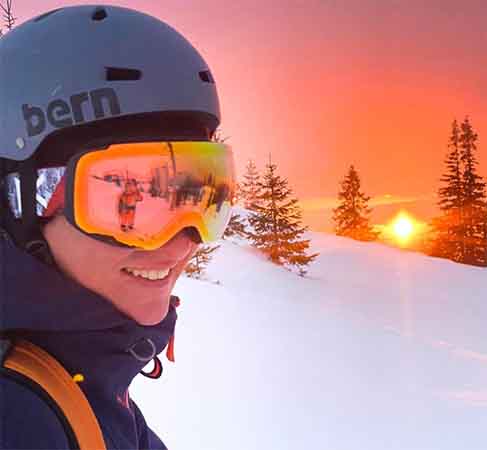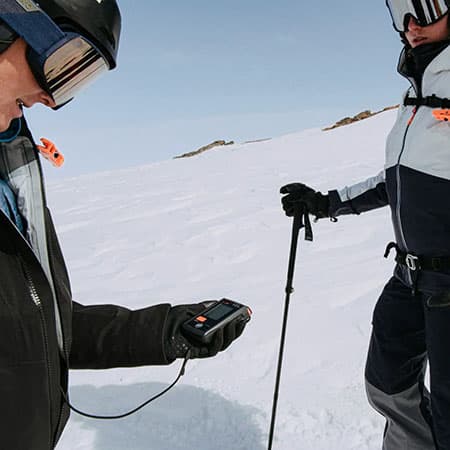
Looking to buy an avalanche beacon? Find out what the best avalanche beacon is in 2023 based on quality, functionality and accuracy tests before you make a purchase.
Having the right avalanche gear when you go on adventures in the mountains or backcountry is crucial. Because the threat is real!

Author bio
“Hi! I’m Manou and I am a former competitive and sponsored freestyle & freeride skier. I’m a ski instructor as well and I practice my passion for skiing for more than 30 years now.“
In this article we’ll share our experiences of many years freeriding in the backcountry. Luckily, we never experienced a real situation were we had to use our avalanche gear.
But you wan’t to be sure you can rely on the best avalanche beacon in case everything goes wrong.
In addition, we’ve spent hours of training over the past years with several types of avalanche beacons.
We are not going to throw you a list of 10 different models with all their specs. The internet is full of that. Instead, we’ll share with you our honest opinion based on our own experiences from the past years.
These product were not given to us or sponsored. We bought them our selves years ago after searching for the best devices ourselves. Neither, are we writing this for highly trained mountain rescue professionals. But for winter sports enthusiasts and mountaineers like ourselves.
That being said, it’s time to dive in!
How does an avalanche beacon work?
An avalanche beacon or transceiver is a device that can both send and search a signal. With help of these devices avalanche victims that are buried by snow can be searched and localized.
What is “the best avalanche beacon”?
Again guys, it’s not necessarily about the specs and neither the more specs the better.
Did you know for instance that some of the most experienced members of the Austrian mountain rescue can still use one of the first avalanche beacon models from the 70′?
These devices did not have visual signals like lights or a screen that pointed you in the direction of a victim. You could only rely on the frequency of the “bieps” to locate the victim.
But why do they still use it? Because they are trained experts and know how to use it accurately.
Let’s face it… most of us are no mountain rescue experts. However, most of the avalanche victims that survive are rescued by their buddies. This is because chances of survival (93%) decrease drastically after 15 minutes of burial.
This means that in most cases there just isn’t enough time for the rescue teams to get on the location in time.

That brings us to the most important aspect for choosing the best avalanche beacon: how well can YOU work with it!
Stressful situation
When the time comes your friend’s life depends on your actions there won’t be much time to think. In addition, you only have 15 minutes so you have a very small time window.
Those 15 minutes include finding the victim first and then shoveling him/her out. The shoveling will take most of your time which means you’ll only have a few minutes to locate your friend.
We are not rescue experts who do this daily. So, you’ll want to have an avalanche beacon that is very reliable, accurate and most important: easy to use!
The specs of the device should all support those 3 aspects.
Specs of the best avalanche transceivers
3 antennas
In terms of accuracy it’s important that the avalanche beacon has 3 antennas.
On the right hand side of the image below you see a device with only one antenna sending a signal.

These beacons will be harder to find compared to a model equipped with 3 antennas. This is because the 3 antennas send a signal in the 3 dimensions. Which will make it easier for the searching transceiver to locate the victim more precisely.

Processor speed
In addition, processor speed is also an important feature that has impact on accuracy.
When you search for a victim you are constantly moving. Which means that your device will be constantly calculating the distance and position based on the signals it’s picking up.
In case of multi-burials it’s even more important to have a device that can calculate fast.
Controls and screen
Since ease of use is absolutely crucial, the best avalanche transceiver is the one with easy controls and a simple screen which gives you clear directions.
There are devices on the market that have a lot of bells and whistles which can only distract you when you want it the least.
The number 1 best avalanche beacon: Mammut Barryvox S
Our all time favorite! Based on our experience we can highly recommend the Mammut Barryvox S.
Mammut has been making avalanche beacons since 1968. They have always been on the forefront of the technical evolution of avalanche transceivers.
We’ve been using the previous model (Mammut Barryvox Pulse) for many years and it ticks all the boxes for us.
Build to last, accurate location determination and most important of all: very easy to use with clear instructions!

The new model Mammut Barryvox S comes with some updated features:
The signal distance, that is the maximum distance that your device will pick up the signal of your friend in need, is nog 70 meters or 229 feet. This is the highest range on the market. In analog mode (without using the screen but only audio), the range is even extended to 100 meters or 328 feet.
Why is this important? The sooner you will pick up a signal during a search, the faster you’ll locate your friend.
During training we’ve noticed that the Mammut Barryvox picks up signals faster compared to most other beacons.

Also important to mention is that the Barryvox manages to direct you to the shortest walking route compared to other avalanche transceivers.
All this means saving time. And considering the 15 minutes window you know how important that is.
It can even send some basic vital data to rescue teams.
The group check function is also a nice addition to the new model.
Mammut Barryvox or Barryvox S?
You can choose between the Mammut Barryvox and his big brother the Baryvox S.
The main functional differences between the two are:
- The Barryvox S has a 40% larger advanced graphics screen compared to the “basic” Barryvox.
- The Barryvox S has two additional buttons to customize the device and activate additional search features that don’t come with the “basic” model.
- Barryvox S comes with “auto guidance” which continues to direct you to the victim even when multiple transceivers are overlapping.
- The Barryvox S can use lithium batteries which last +-400 hours vs +-250 for the Barryvox using alkaline batteries. And lithium batteries can’t leak corrosive acid.
We would advise to go for the Barryvox S since it gives clearer visual direction in our opinion.
However, there is a price difference between the two models. The Barryvox is priced $385 on the official Mammut website. The Barryvox S is priced at $549.
They are both available on Amazon.
3 part rescue kit essentials
Be aware that wearing an avalanche beacon alone is not enough. The essential avalanche rescue gear you should always take with you is: an avalanche beacon, a probe and a shovel.
If you don’t have any of those it’s probably best to buy a pack from Mammut with transceiver, probe and shovel.

Finally, we would like to mention that acquiring the right gear is just the first step but not enough. Get to know at least the basics of avalanche safety and risk management before you head into the backcountry. Practice with your friends at the beginning of the winter season so you get to know your gear and search rescue procedures.
Keep it safe but most of all have fun!
ALSO READ: “Heli skiing: the ultimate winter adventure”